- Home
- Concepts&Theories
- Sufficiency Economy & New Theory
- About us
- Concepts
- Philosophy of Sufficiency Economy
Philosophy of Sufficiency Economy
“Economic development must be done step by step. It should begin with the strengthening of our economic foundation, by assuring that the majority of our population has enough to live on…Once reasonable progress has been achieved, we should then embark on the next steps, by pursuing more advanced levels of economic development.”
“Being a tiger is not important. The important thing is for us to have a sufficient economy. A sufficient economy means to have enough to support ourselves…we have to take a careful step backward…each village or district must be relative self-sufficient.”
His Majesty King Bhumibol Adulyadej
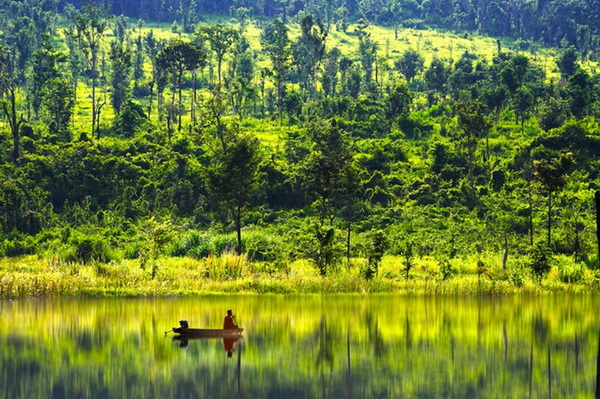
Modern development has caused changes in all aspects of Thai society. The positive impacts of the development are economic growth, progress of material and public utilities, modern communication systems, and improvement and expansion of education. However, few of these results have reached rural areas or the underprivileged in the society.
On the other hand, rapid economic growth and the rise of consumerism has led to a state of economic dependence and deterioration of natural resources as well as the dissolution of existing kinship and traditional groups to manage them. The traditional knowledge and wisdom that have been employed to solve problems and accumulated in the past are forgotten and have started to disappear.
Significantly, what has dissipated is the people’s ability to rely on themselves and conduct their lives and pursue their destiny with dignity. For Thailand, the 1997 economic crisis served as a costly lesson of unbalanced and unstable growth, partly due to the improper economic and social development process, in which the economy relied heavily on foreign capital inflows and external markets.
The Royal Initiative of the ‘Philosophy of Sufficiency Economy’
Although His Majesty has been promoting self-reliant or sustainable farming since the 1950s, it is generally accepted that the idea of Sufficiency Economy had been brought up in the 1970s during in His Majesty’s speeches.
Sufficiency Economy is a philosophy based on the fundamental principle of Thai culture. It is a method of development based on moderation, prudence, and social immunity, one that uses knowledge and virtue as guidelines in living. Significantly, there must be intelligence and perseverance which will lead to real happiness in leading one’s life.

“…I ask all of you to aim for moderation and peace, and work to achieve this goal. We do not have to be extremely prosperous…If we can maintain this moderation, then we can be excellent…”
His Majesty the King’s Statement given on 4 December 1974
In this royal statement, His Majesty concerned that modern development which emphasized only the economic expansion might eventually lead the country to crisis. Therefore, he stressed the importance of building a ‘good and stable foundation’ before further progress could be developed. This means that instead of putting the emphasis on the expansion of the industrial sector prior to development, the stability of the basic economy should be established first, that is, assuring that the majority of rural people have enough to subsist first. This is a method of development that stresses the distribution of income to build the overall economic foundation and stability of the country before going on to a higher level of development.
On a personal level, the Philosophy of Sufficiency Economy can be adopted by all people simply by adhering to the middle path. The awareness of virtue and honesty is also essential for people as well as public officials.
The Philosophy of Sufficiency Economy and its Three Pillars
- Moderation: Sufficiency at a level of not doing something too little or too much at the expense of oneself or others, for example, producing and consuming at a moderate level.
- Reasonableness: The decision concerning the level of sufficiency must be made rationally with consideration of the factors involved and careful anticipation of the outcomes that may be expected from such action.
- Risk Management: The preparation to cope with the likely impact and changes in various aspects by considering the probability of future situations.
Decisions and activities must be carried out at a sufficient level depending on two conditions:
Knowledge, comprising all-round knowledge in the relevant fields and prudence in bringing this knowledge into consideration to understand the relationship among the field so as to use them to aid in the planning and ensure carefulness in the operation.
Virtue to be promoted, comprising the awareness of honesty, patience, perseverance, and intelligence in leading one’s life.
The Philosophy of Sufficiency Economy and National Development
His Majesty’s Philosophy of Sufficiency Economy emphasizes that the producers or consumers try to produce or consume within the limit or limitation of existing income or resources first. This is the principle in decreasing the dependence and increasing the ability to control the production themselves, thus deceasing the risk from not being able to efficiently control the market system.
Sufficiency Economy does not mean that one must constantly be frugal. A person can indulge himself in luxury once in a while, provided that it is within his capacity to do so. But the majority of the country’s population often overspends beyond their means. Sufficiency Economy can lead to the goal of establishing economic stability. Fundamentally, Thailand is an agricultural country; therefore, the country’s economy should be keyed towards agro-economy and food stability in order to establish a stable economic system to a certain degree. This is an economic system that can help lessen the risk or economic instability in the long run.
“I may add that full sufficiency is impossible. If a family or even a village wants to employ a full sufficiency economy, it would be like returning to the Stone Age…This sufficiency means to have enough to live on. Sufficiency means to lead a reasonably comfortable life, without excess, or overindulgence in luxury, but enough. Some things may seem to be extravagant, but if it brings happiness, it is permissible as long as it is within the means of the individual…”
His Majesty’s birthday speech on 4 December, 1998
Sufficiency Economy can be applied to all levels, branches, and sectors of the economy. It is not necessarily limited to the agricultural or rural sectors, or even the financial, the real estate, and the international trade and investment sectors by using similar principles of emphasizing moderation in performance, reasonableness, and creating immunity for oneself and society.
The Philosophy of Sufficiency Economy as Life Guidance
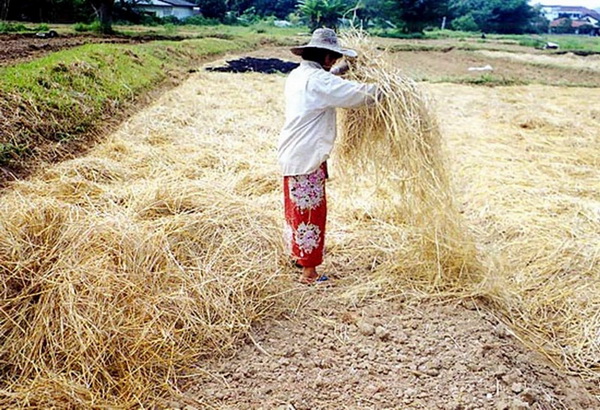
His Majesty the King has comprehensive understanding of Thai society. Thus, in granting initiatives or delivering advice he would also take into consideration the people’s way of life and social norms to avoid internal conflicts that may obstruct the implementation.
How to lead a life in accordance with the Philosophy of Sufficiency Economy
- Adhere to economizing by cutting down expenses in all aspects and forego extravagances in leading one’s life.
- Adhere to pursuing one’s occupation with decorum and honesty.
- Stop contending for beneficial gains and using harsh methods in commercial competition.
- Never cease to find a way to escape hardship by attempting to gain knowledge in order to increase one’s income to the point of sufficiency.
- Leading one’s life by following the good path, avoiding the bad, and adhering to religious principles.
The New Theory
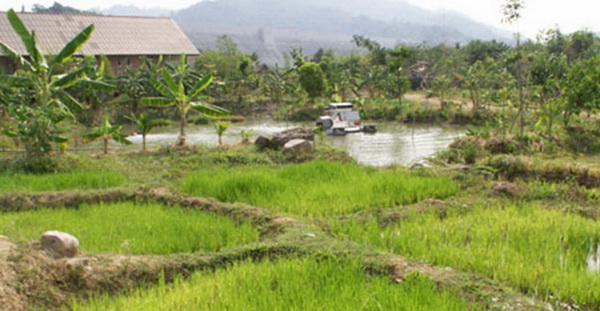
Rationale
The New Theory is the most distinct and concrete example of the application of the Philosophy of Sufficiency Economy to the agricultural sector. His Majesty King Bhumibol initiated this theory to help Thai farmers who suffer from the impacts of economic crisis, natural disasters and other unproductive natural conditions.
The New Theory suggests that farmers apply the essential principles of the Philosophy of Sufficiency Economy, namely moderation, due consideration and self-immunity to their practice of farming as this would shield them from the risks and impacts of globalization and other uncontrollable factors in their farming.
The Risks and Impacts of Farming
- Price fluctuation of agricultural produce and commodities as a result of modern economic development
- Unproductive conditions such as dry spells and droughts
- Natural disasters such as flooding and epidemics
- The patterns of production such as plant diseases and pest problems, lack of manpower, debts, and loss of land
His Majesty believed that if the farmers acted with due consideration based on knowledge of past price fluctuations of agricultural commodities they would see how risky it is to concentrate all one’s resources in such commodities expecting large profits. And if they adopted the principle of self-immunity, they would prepare for price changes in the market by producing enough to eat as a priority and only then think of selling any surplus.
New Theory: Integrated and Sustainable Agricultural System
In a more tangible sense, His Majesty developed the New Theory as a system of integrated and sustainable agriculture, embracing his thoughts and efforts in water resource development and conservation, soil rehabilitation and conservation, sustainable agriculture and self-reliant community development. The aim is to optimize farmland.
Key Formula
In tune with the Philosophy of Sufficiency Economy, His Majesty introduced the unprecedented approach to manage farmland. Efficient water management was also developed to ensure year-around farming. To adopt the New Theory agriculture, farmers are advised to follow these three steps:
Phase I
Farmland Division for Optimum Benefits
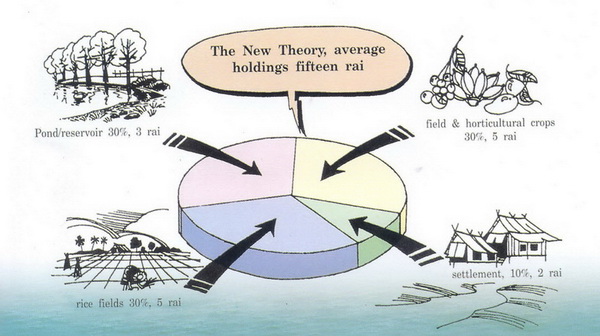
The land is divided into four parts with a ratio of 30:30:30:10.
The first 30% is designated for a pond to store rainwater during the rainy season while during the dry season it serves to supply water to grow crops and raise aquatic animals and plants.
The second 30% is set aside for rice cultivation during the rainy season for the family’s daily consumption throughout the year to cut down on expenses and allow the farmers to be self-reliant.
The third 30% is used for growing fruit and perennial trees, vegetables, field crops and herbs for daily consumption. If there is any surplus, it will be sold.
The last 10% is set aside for accommodation, animal husbandry, roads and other structures.
Phase II
Communal Agriculture
After the first step has been realized, the farmers are encouraged to form groups or cooperatives to carry out farming and agricultural activities in the following areas:
Production (plant species, soil preparation, irrigation, etc.)
Farmers must cooperate in the production of crops, starting from preparing the soil, obtaining plant species, fertilizers, water supply, etc. for cultivation.
Marketing (rice drying space, silos, rice mills, the sale of crops)
When the rice crops are harvested, there must be preparations in many areas to gain the highest profits from them: preparing a common drying space, silos, rice mills, as well as cooperating in selling the produce to obtain good prices and cut down on expenses.
Living conditions (fish paste, fish sauce, food, clothing, etc.)
At the same time farmers must maintain a certain degree of proper living with sufficient basic requisites such as food, fish paste, fish sauce, and clothing.
Welfare (public health, loans)
In each community there should be necessary welfare and services, such as a health center in time of sickness or a fund providing loans to be used to carry out activities in the community.
Education (schools, scholarships)
The community should play an active role in promoting education, for example, setting up an education fund for children in the community.
Society and religion
The community should be the center for social and mental development, with religion as the binding factor.
All the aforementioned activities must receive cooperation from all parties concerned whether government or private sector, as well as members of the community.
Phase III
Loan and Credit Outreach
After the second phase, the farmers should move into the third phase by making contacts with banks or private companies to obtain funds to assist with investment or developing their quality of life. In this way, both farmers and banks or private companies will gain mutual benefits as follows.
- Farmers can sell their rice at a high price (since they are not forced to sell cheaply)
- Banks or private companies can buy rice for consumption at a low cost (by buying paddy directly from the farmers and milling it them themselves)
- Farmers can buy consumer products at a low cost since they buy them together in large quantities (from cooperatives stores at a wholesale price)
- Banks or private companies are able to disperse their personnel to carry out various activities for better results
Principles and Methods
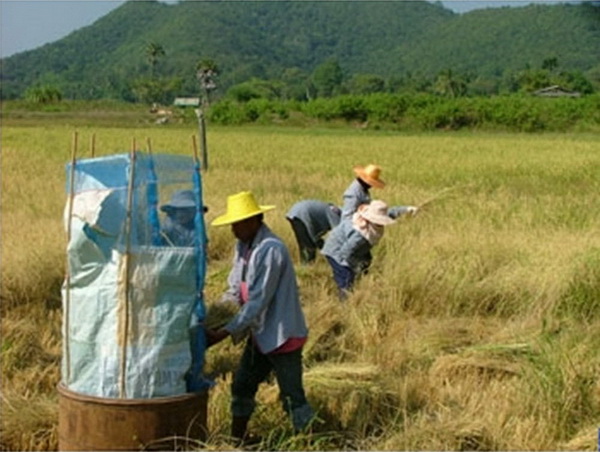
- The New Theory is a production system based on Sufficiency Economy by which farmers can subsist at an economical level first, provided that the community must unite and cooperate in helping one another along the line of long khaek or mutual-help tradition to cut down on labor expenses.
- Since rice is the staple food consumed by every household, it is estimated that each family must grow rice on approximately 5 rai (8,000 square meters) of land to have enough rice for year-round consumption without having to buy it at an expensive price, thus enabling them to be self-reliant.
- There must be a sufficient reserve of water to be used for cultivation in the dry season or during the dry spell. Therefore, it is necessary to set aside a part of the land to dig a pond on the principle that there must be enough water for cultivation the whole year round. According to His Majesty the King’s calculation, to cultivate 1 rai (1,600 square meters) of land requires about 1,000 cubic meters of water. So, for growing 5 rai of rice and 5 rai of field crops or fruit trees (10 rai in all) there must be about 10,000 cubic meters of water per year.
Thus, on a premise that the land to be cultivated is 15 rai, it can be roughly divided into:
5 rai for rice field
5 rai for field crops
3 rai for a pond, 4 meters deep with a capacity to store about 19,000 cubic meters of water, the amount sufficient for use in the dry season
2 rai for accommodation and other purposes, bringing the total up to 15 rai.
However, the size of the pond depends on the topography and the environment as follows:
- If the land is to be used for cultivation that relies on rainwater, then the pond should be deep to prevent water from evaporating too much, so there will be enough water for the whole year.
- If the land is in an irrigated area, then the pond can be deep or shallow, and narrow or wide as may be suitable, since there is a continual supply of water.
The reason for the pond is for the farmers to have water for use all year round on a regular basis (His Majesty calls this a ‘regulator,’ meaning a good control with a continual water circulation system for cultivation), especially in the dry season and during dry spells. However, it does not mean that farmers can grow off- season paddy since if the amount of water in the pond is insufficient, then water has to be conveyed from a nearby dam, if there is one, which may cause the water in the dam to be depleted. Farmers should grow rice in the rainy season. In the dry season or during dry spells they should use the stored water to the highest benefit agriculturally by growing crops suitable to the seasons in order to have other produce for consumption and also for sale all year round.
- His Majesty’s division of land to achieve the highest benefit has been calculated and considered from the rate of land tenure of 15 rai per household. However, farmers with less or more land can also apply the ratio of 30:30:30:10 to their land as follows.
The first 30% is used to dig a pond (where fish can be raised and aquatic plants such as morning glory can be grown). Above the pond chicken coops can be built and along the banks of the pond perennial trees that do not need much water to subsist can also be grown.
The second 30% is used for rice farming.
The third 30% is used to grow field crops and orchard trees (fruit trees, perennial trees, trees whose wood can be used for general purposes, for firewood, or for construction, field crops, vegetables, and herbs).
The final 10% is for accommodation and other purposes (paths, levees, haystacks, space for drying compost, sheds, for mushroom culture, animal pens, flower and ornamental plants, and a kitchen garden).
Nevertheless, the above ratio is only a rough formula or principle that can be changed or improved depending on the conditions of the terrain, the amount of rainfall, and the environment. For example, in the South where it rains constantly or in areas where water sources are available to refill the pond, the size of the pond can be reduced to make room for other uses.
- There are several factors involved in carrying out the New Theory depending on the topography and the environment of each locality. Therefore, farmers should be advised by officials. The most significant thing is the cost of investment is rather high, especially for digging the pond. Farmers must receive help from the government, foundations, and the private sector.
- While the pond is being dug, the topsoil which is fertile should be piled aside to be used for growing plants later on by spreading it over the lower level soil which is less fertile, or it can be otherwise utilized to build the edge of the pond or beds to grow fruit trees.
Recommended Crops and Animals for New Theory Farming
Fruit trees and perennial plants:
Mango, coconut, tamarind, jackfruit, sapodilla, orange, banana, custard apple, papaya, santol, horseradish, neem tree
Short-lived vegetables and flowers:
Sweet potato, taro plant, yard long bean, eggplant, jasmine, Aztec, globe amaranth, rose
Mushroom:
Nang fah mushroom (Pleurotus sajor-caju), straw mushroom, abalone mushroom (Pleurotus cystidiosus)
Herbs and spices:
Areca palm, betel pepper, pepper, elephant yam, Centella asiatica, ebony tree, ringworm bush, vetiver grass, as well as certain types of crops such as holy basil, common basil, mint, lemongrass
Wood and firewood:
Bamboo, coconut, palm, coral tree, lead tree, eucalyptus, neem tree, cassod tree
Field crops:
Maise, soybean, groundnut, cowpea, pigeon pea, sugarcane, cassava, castor, kapok
Soil nourishing and ground cover crops:
Pigeon pea, sword bean, cassod tree, lead tree, green pea
Animals:
Pigs, chickens and aquatic animals such as common carp, nile tilapia, common silver barb, catfish, frogs
Note: Various plants are more useful than others. When growing plants perennial plants should be given precedence since they need less maintenance in the long run and they give yields regularly all year round. Various species of perennial trees should be selected to give shade and moisture to dwelling places and the environment. The plants should be selected according to the conditions of the terrain, for example, eucalyptus should not be planted along the edge of the pond. Fruit trees should be grown instead.
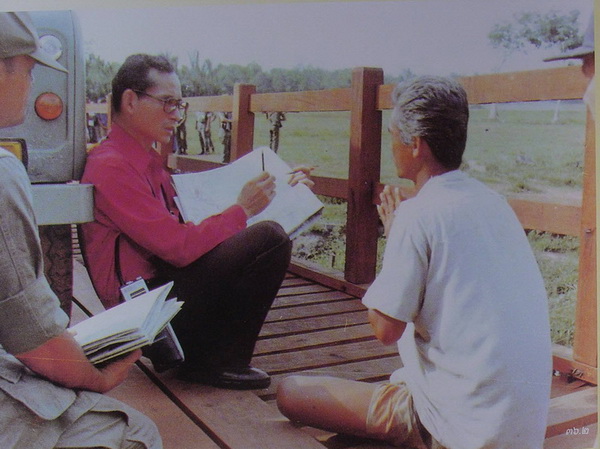
Benefits of the New Theory Agriculture
- The people can live moderately at an economical level, without having to starve, and can be self-reliant according to the ‘Sufficiency Economy’ philosophy.
- In the dry season when water is scarce, the water stored in the pond can be used to grow vegetables that can thrive on a small amount of water without having to rely on the irrigation system.
- In years when it rains in season with rainwater available all year round, the New Theory can earn income for the farmers who do not have to worry about expenses.
- In case of floods, farmers can recuperate and help themselves to a certain degree without needing much assistance from the government, a save on the budget in a way.
The Ideal New Theory
The New Theory operated by relying on natural water sources or rainwater can be rather “precarious” since in years that rain is scarce the amount of water may be insufficient. Therefore, in order to realize the full potential of the New Theory it is necessary to have an efficient water detention pond with full capacity by having a large water source that is always able to refill the pond. For example, in the case of the experiment at the Royal-initiated Wat Mongkhol Chaipattana Development Project, Saraburi province His Majesty has suggested the following methods:
The ideal New Theory system
Large reservoir filling small reservoir, small reservoir filling pond

As seen the illustration, the small circles are ponds that farmers have dug according to the New Theory. When water is scarce in the dry season, they can draw water from these ponds for use. If there is not enough water in the ponds, they can get water from Huai Hin Khao Reservoir (small reservoir), from where water delivery pipelines have been laid down to the ponds dug in each plot of land. In this way, water is available for use the whole year round.
In case the amount of water used by farmers is considerable and the volume of water in Huai Hin Khao Reservoir (small reservoir) is insufficient, water may be conveyed from Pa Sak Jolasid Dam (big reservoir) to Huai Hin Khao Reservoir (small reservoir), which will help refill the volume of water in the farmers’ ponds without their having to face the risk of water scarcity.
The system of water resources management initiated by His Majesty the King is able to render the most efficient use of water conveyed through the pipelines system to the plots of land by three to five times the average. This is because in the rainy season, besides the water in the reservoirs, there is also water stored in the farmers ponds, thereby increasing the amount of water hugely. The water in the reservoirs connected to the ponds will only serve as reserve water sources for repletion.
‘New Theory’ Demonstration Projects of the Chaipattana Foundation
For more information and how to visit the ‘New Theory’ demonstration farms please contact:
1. The Department of Projects Management
Office of the Chaipattana Foundation
Dusit Palace, Sri Ayutthaya Road
Dusit, Bangkok 10300
Tel: 02 282 4475
Fax: 02 282 3341
2. The Royally-initiated Wat Mongkhol Chaipattana Development Project
Saraburi Province
Tel/Fax 036 499 181
3. The Royally-initiated Integrated Farming Demonstration Farm (the New Theory)
Pak Thor Sub-district, Ratchaburi Province
Tel/Fax 032 337 407
4. Suan Somdech Phra Sri Nagarindra Project (The Late Princess Mother Garden Project)
Cha-am Sub-district, Phetchaburi Province
Tel/Fax 02 359 4067
5. The New Theory Demonstration Project
Khao Wong Sub-district
Kalasin Province
Tel/Fax 043 859 089
6. The New Theory Demonstration Project
Pak Thong Chai Sub-district
Nakhon Ratchasima Province
Tel/Fax 044 325 048